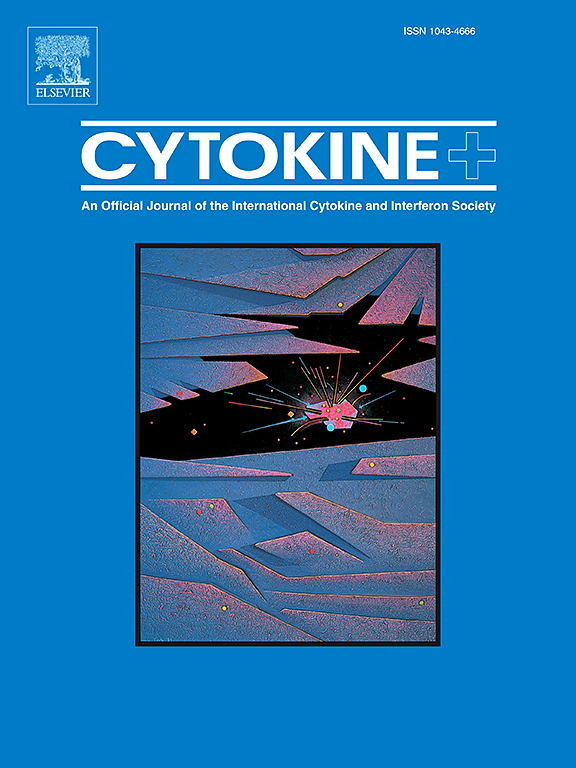基于人群队列的细胞因子图谱SHIP-TREND-0 -与年龄、性别和BMI相关
IF 3.7
3区 医学
Q2 BIOCHEMISTRY & MOLECULAR BIOLOGY
引用次数: 0
摘要
背景:在基于人群的队列中,生理免疫特征的表征是识别与炎症或自身免疫性疾病相关的病理免疫特征的先决条件。方法在这里,使用FLEXMAP 3D™仪器,采用基于头部的多重测定法(默克HCYTA-60 K)对1175名波美拉尼亚健康研究(SHIP;TREND队列,532名男性和643名女性,年龄:20至81岁,BMI: 17.7至53.6)。细胞因子浓度与年龄、性别、BMI、季节和血细胞参数(BCP)的关系通过多变量回归模型进行检验。结果不同分析物的生理细胞因子浓度差异较大,中位浓度在0.6 ~ 7820 pg/mL之间。许多细胞因子水平在研究人群中显示出很大的动态范围。促炎细胞因子和趋化因子IL-6、IL-8、CXCL9、CXCL10、IL-12p40、CCL2、CCL4、CCL11、IL-27、FLT3LG和TNFα水平升高与年龄增长显著相关。年龄相关性最强的是CXCL9 (βst = 0.4, p <;0.001)和CXLC10 (βst = 0.3, p <;0.001)。CCL2、CCL3、CCL4、CCL11、CCL22、IL-12p40、IL-1RA、IL-18、IL-27、tnf - α水平存在显著性差异,其中CCL11的影响最大(βst = - 0.24, p <;0.001),女性的水平低于男性。此外,CCL4、CCL22、CXCL10、IL-1RA、IL-18、IL-6、tnf - α等7种细胞因子和趋化因子水平随着BMI的升高而升高。其中IL-1RA效果最强(βst = 0.19, p <;0.001), CCL4 (βst = 0.16, p <;0.001)和CXCL10 (βst = 0.14, p <;0.001)。只有CCL11 (βst = - 0.17, p <;0.001)随着BMI的增加而降低。被归类为肥胖的受试者表现出CCL4、CCL22、CXCL10和IL-1RA水平显著升高,而与正常体重相比,只有CCL11水平显著降低。某些细胞因子如IL-6、IL-18或tnf - α在调整血细胞成分后显示显著性水平降低,表明血细胞成分(bcp)是潜在的混杂因素。我们观察到所研究的细胞因子没有显著的非线性季节效应。结论生成的细胞因子图谱提供了普通人群细胞因子变异的详细信息,为今后疾病相关研究提供参考依据。此外,在基于血浆细胞因子水平的关联研究中,bcp应被视为潜在的混杂因素。本文章由计算机程序翻译,如有差异,请以英文原文为准。

Cytokine atlas of the population-based cohort SHIP-TREND-0 – Associations with age, sex, and BMI
Background
The characterization of physiological immune signatures in a population-based cohort is a prerequisite for identifying pathological immune signatures associated with inflammatory or autoimmune diseases.
Methods
Here, 47 plasma cytokines, chemokines, and growth factors were quantified with a bead-based multiplex-assay (Merck HCYTA-60 K) using a FLEXMAP 3D™ instrument in 1175 individuals of the Study of Health in Pomerania (SHIP; TREND cohort, 532 men and 643 women, age: 20 to 81, BMI: 17.7 to 53.6). Associations of cytokine concentrations with age, sex, BMI, season, and blood cell parameters (BCP) were examined by multivariate regression models.
Results
The physiological cytokine concentrations differed strongly between analytes, with median concentrations ranging from 0.6 to 7820 pg/mL. Many cytokine levels showed a large dynamic range within the study population. Higher levels of the pro-inflammatory cytokines and chemokines IL-6, IL-8, CXCL9, CXCL10, IL-12p40, CCL2, CCL4, CCL11, IL-27, FLT3LG, and TNFα were significantly associated with increasing age. The strongest age-associated effects were seen for CXCL9 (βst = 0.4, p < 0.001) and CXLC10 (βst = 0.3, p < 0.001). Significant sex differences were detected for CCL2, CCL3, CCL4, CCL11, CCL22, IL-12p40, IL-1RA, IL-18, IL-27, and TNFα levels among which CCL11 showed the strongest effect (βst = −0.24, p < 0.001) with a lower level in women compared to men. Moreover, seven cytokines and chemokines, i.e. CCL4, CCL22, CXCL10, IL-1RA, IL-18, IL-6, and TNFα, displayed higher levels with increasing BMI. Among those, the strongest effect was seen for IL-1RA (βst = 0.19, p < 0.001), CCL4 (βst = 0.16, p < 0.001) and CXCL10 (βst = 0.14, p < 0.001). Only CCL11 (βst = −0.17, p < 0.001) decreased with increasing BMI. Subjects categorized as obese exhibited significantly elevated levels of CCL4, CCL22, CXCL10, and IL-1RA, while only CCL11 showed significantly reduced levels compared to normal weight. Certain cytokines such as IL-6, IL-18, or TNFα showed decreased significance levels after adjustment for blood cell components indicating blood cell components (BCPs) as potential confounders. We observed no significant non-linear seasonal effects for the investigated cytokines.
Conclusion
The generated cytokine atlas provides detailed information on cytokine variations in the general population and will provide a reference base for disease-related studies in the future. Furthermore, BCPs should be considered as potential confounders in association studies based on plasma cytokine levels.
求助全文
通过发布文献求助,成功后即可免费获取论文全文。
去求助
来源期刊

Cytokine
医学-免疫学
CiteScore
7.60
自引率
2.60%
发文量
262
审稿时长
48 days
期刊介绍:
The journal Cytokine has an open access mirror journal Cytokine: X, sharing the same aims and scope, editorial team, submission system and rigorous peer review.
* Devoted exclusively to the study of the molecular biology, genetics, biochemistry, immunology, genome-wide association studies, pathobiology, diagnostic and clinical applications of all known interleukins, hematopoietic factors, growth factors, cytotoxins, interferons, new cytokines, and chemokines, Cytokine provides comprehensive coverage of cytokines and their mechanisms of actions, 12 times a year by publishing original high quality refereed scientific papers from prominent investigators in both the academic and industrial sectors.
We will publish 3 major types of manuscripts:
1) Original manuscripts describing research results.
2) Basic and clinical reviews describing cytokine actions and regulation.
3) Short commentaries/perspectives on recently published aspects of cytokines, pathogenesis and clinical results.
 求助内容:
求助内容: 应助结果提醒方式:
应助结果提醒方式:


